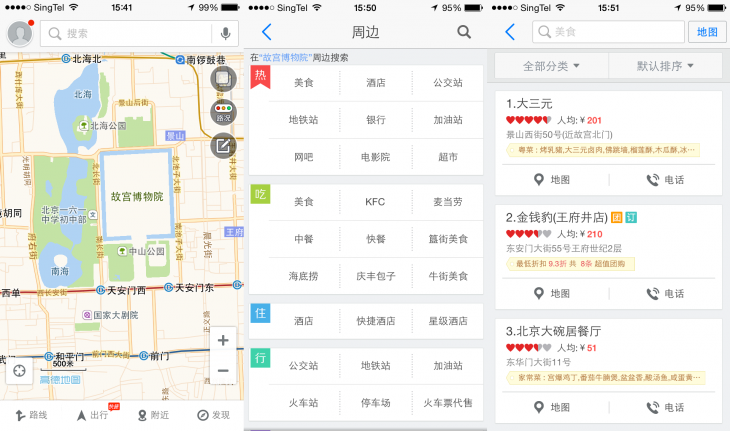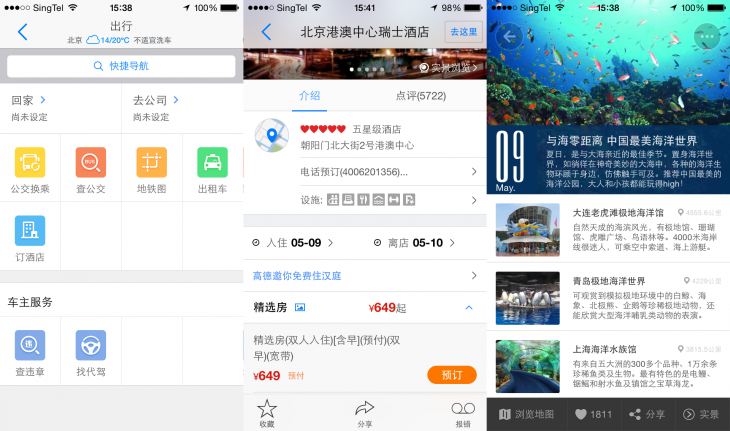
The race to conquer mobile mapping in China is getting extremely heated.
Earlier this week, China’s largest Internet firm Tencent bought an 11.3 percent stake in Chinese mapping provider NavInfo for CNY1.17 billion ($187 million). The deal could see NavInfo services integrated into WeChat, Tencent’s mobile messaging app which boasts 355 million active users worldwide with most in China.
Tencent’s move came only weeks after Alibaba sank $1.15 billion to buy AutoNavi, a larger rival to NavInfo — which in turn came nearly a year to the day that Alibaba first invested in AutoNavi, shelling out $294 million for a 28 percent stake.
Amid the competition between Tencent and Alibaba, Baidu has also been quietly beefing up its mobile maps service. Company CEO Robin Li revealed on a recent earnings call that Baidu Maps has a 54 percent market share in China, according to research from China Information Technology (CNIT).
With Tencent’s move though, the mapping ecosystem in China has become extremely complicated. NavInfo provides mapping data for Baidu among other businesses, while AutoNavi provides for firms including Tencent-linked Dianping, known as ‘China’s Yelp’. Last year, NavInfo tried to tap onto the consumer market by launching an app — which seems to have gone off the radar now — after Baidu and AutoNavi made the move to offer their navigation apps for free.
AutoNavi’s plans to attract users
In response to all the heated competition among companies to conquer consumer-facing mobile mapping, George Qie, AutoNavi’s vice president of its mobile business group, told TNW at the sidelines of GMIC Beijing that it is increasing its efforts in location-based services for its mapping app, which was launched in 2011.
This is a bid to increase stickiness on the platform, as Qie admitted that it is hard to get users to spend much time on standalone mapping apps. “The special characteristic of traditional mapping apps is that there is solid demand for it, but the usage rate is very low. When you need it, you really need it. But you only use it when you can’t find your way.”
However, Qie said that AutoNavi is trying to increase the active usage rate on its mapping app is to integrate other services, such as traffic monitoring, hotel look-up and shopping location search. With the trend moving toward “super-apps” or apps that integrate services like mapping, payments, shopping and communication, such concerns are key contributors to AutoNavi’s tie-up with Alibaba.
Integrating such commercial lifestyle services is one of the key reasons why we have tied up with Alibaba, and it will definitely help us greatly…
You have many needs in your daily lives and it’s very convenient to find things through the maps app, after we have integrated such services. The thing is that most people don’t realize some of its uses. We have added in a lot of information and services, especially live information, so you can build up a habit of turning to your maps app, just like a browser or search app. Once users subscribe to this idea, that is when maps will truly take off, and it’s our ultimate vision.
Qie cited an example of how the usage rate of AutoNavi’s mapping app spiked during festivals such as Qingming and Labor Day, as people relied on maps when they were in an unfamiliar location while traveling to find hotels and restaurants.
“We want to integrate more day-to-day services so much so that people will use it even when in a familiar location, no matter whether making reservations for restaurants or shopping or hailing taxis,” he said.
In the West, Google has also likely realized the need for people to turn to maps by integrating Uber recently into its Google Maps app for Android and iOS, and adding new search filters for restaurants, bars and hotels, including opening hours, ratings and prices.
Fending off competition
Already, AutoNavi’s increased focus on online to offline services seems to be paying off. In a report for its fiscal 2013 results, AutoNavi’s CEO noted that the number of online-to-offline service orders made through AutoNavi’s free mobile map app increased “dramatically” in the fourth quarter, although it was still a relatively low base.
Qie acknowledged that Tencent’s move speaks for the determination it has in stepping into providing mapping services, and could pose a threat in the long run:
Tencent definitely has an edge because it has so many consumer platforms like Weixin (the version of WeChat in China) to build an ecosystem, so it could pose a challenge to us in terms of location-based integrated services.
However, he also noted that even though Tencent has partnered with NavInfo, the company is coming late into the game and it could take some time to get up to speed.
What’s more, he personally feels that Baidu could take a bigger hit from Tencent’s move. “It’s difficult to say which company will emerge tops, as things move very fast, but we believe AutoNavi can build on what we have so far, which is an advantage,” he said.
In any case, it is clear that the trend of mobile mapping in China is moving towards integrating online to offline services. Focusing on bringing convenience to app users should, and will, be key in changing the way mobile maps are being used in the country now and in the near future, which is why all three Internet giants have their eye set on doing so.
Headline image via Shutterstock
Get the TNW newsletter
Get the most important tech news in your inbox each week.






